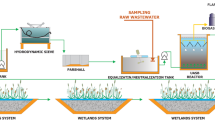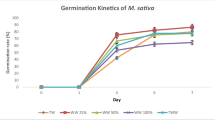Abstract
The aim of this study is to evaluate the seasonal changes in leachate compositions, and their impact on germination tests and α-amylase activity. Throughout the four seasons of the year 2022, leachate samples were collected in autumn, winter, spring, and summer directly from the collection conduit of the untreated leachate pond at Mediouna landfill (Casablanca, Morocco). The parameters analyzed in the leachate samples included pH, electrical conductivity (EC), chemical oxygen demand (COD), 5-day biochemical oxygen demand (BOD5), nitrate (NO3−), ammonium (NH4+), and orthophosphate (PO43−). The present study involved the execution of germination tests on municipal solid waste leachate. Lens culinaris and Medicago sativa seeds were exposed to leachate at different dilutions of 1%, 3%, 5%, 7%, and 10%, with tap water as control, for about 72 h in the dark at room temperature. Severe toxicity was observed for the 7% and 10% concentrations, observing that L. culinaris and M. sativa showed a mean value of germination index inferior to 50%. These results can be explained by the presence of inhibitor elements in the leachate such as heavy metals (Pb and Hg) and sodium. Lead (Pb) and mercury (Hg) have mean concentrations of 0.2276 ppm and 0.0159 ppm, respectively, while sodium (Na) exhibits an average concentration of 359.942 ppm. In addition, for the biochemical parameters, we noted a decrease in α-amylase activity proportionally to the germination index. In conclusion, this work highlights the significant metabolic disturbances induced by leachate, harming the germination of L. culinaris and M. sativa seeds. The present results highlight the potential deleterious effects of leachate pollution on agricultural activities and the ecosystem. However, it may also be possible to take advantage of the leachate’s richness in organic matter and nutrient salts to fertilize agricultural land. Our next investigations will aim to verify whether the use of leachate as fertilizer will cause damage to crops and soil.





Similar content being viewed by others
Data availability
No data was used for the research described in the article.
References
Anand A, Singh S (2014) Membrane technique for leachate treatment: a literature review. Int J Environ Res Dev 4:33–36
AOAC International Guidelines for Collaborative Study Procedures to Validate Characteristics of a Method of Analysis (1995) J AOAC Int. 78:143A-160A
Baderna D, Caloni F, Benfenati E (2019) Investigating landfill leachate toxicity in vitro: a review of cell models and end points. Environ Int 122:21–30. https://doi.org/10.1016/j.envint.2018.11.024
Benhamdi A, Kandouli C, Cherfia R, Chelouche S, Boumissa Z, Benniou ME, Hafdi R, Mechakra A (2021) Effect of zinc on the growth and the antioxidant system of lens culinaris cultivated on agar medium. J Ecol Eng 22(9):13–20. https://doi.org/10.12911/22998993/141532
Berbezy P (1995) Étude des remaniements glucidiques dans les mérithalles de sarments de vigne en période hivernale et sous l'action du froid. Identification des isoformes d'alpha-amylases présentes et purification de l'une d'entre elles. Thesis, Reims, France
Bradford MM (1976) A rapid and sensitive method for quantitation of microgram quantities of protein utilizing the principle of protein-dye binding. Anal Biochem 72:248–254. https://doi.org/10.1016/0003-2697(76)90527-3
Cherni Y, Elleuch L, Messaoud M et al (2021) Recent technologies for leachate treatment: a review. Euro-Mediterr J Environ Integr 6:79. https://doi.org/10.1007/s41207-021-00286-z
Chichaoui H (2008) Waste Financing, Case of Casablanca. Thesis, ISCAE, Morocco
De Almeida R, Porto RF, Quintaes BR, Bila DM, Lavagnolo MC, Campos JC (2023) A review on membrane concentrate management from landfill leachate treatment plants: the relevance of resource recovery to close the leachate treatment loop. Waste Manage Res 41(2):264–284. https://doi.org/10.1177/0734242X221116212
Fekri A (2007) Impact de la Décharge de Médiouna sur les Ressources en Eaux Souterraines. University Hassan II Thesis
Florin B, Garret P (2017) La décharge de Médiouna : la quête du reste ultime (Casablanca). In: Denis C, Tastevin Y Vies d’ordures. De l’économie des déchets, Edition Artlys et MuCEM. halshs-01524893, France, pp. 202–204. https://shs.hal.science/halshs-01524893
Germani MS, Small M, Zoller WH, Moyers JL (1981) Fractionation of elements during copper smelting. Environ Sci Technol 15:299–305. https://doi.org/10.1021/es00085a005
Ghalloudi J, Ghalem Z, Talbi M (2015) Evaluation de la première expérience de gestion déléguée des déchets ménagers à Casablanca, Maroc. Eur Sci J 11:1857–7881
Gripa E, Dario Alves Daflon S, De Almeida R, Da Fonseca FV, Campos JC (2023) Landfill leachate treatment by high-pressure membranes and advanced oxidation techniques with a focus on ecotoxicity and by-products management: a review. Process Saf Environ Prot 173:747–764. https://doi.org/10.1016/j.psep.2023.03.074
Hafidi M (2015) L’impact et la gestion des déchets solides. Konrad-Adenauer-Stiftung E.V.
Jorstad LB, Jankowski J, Acworth RI (2004) Analysis of the distribution of inorganic constituents in a landfill leachate contaminated aquifer: Astrolabe Park, Sydney, Australia. Environ Geol 46:263–272
Kim YD, Lee DG (2009) Comparative study on leachate in closed landfill sites: focusing on seasonal variations. J Mater Cycles Waste Manag 11:174–182. https://doi.org/10.1007/s10163-008-0246-9
Kumar A, Samadder S (2017) A review on technological options of waste to energy for effective management of municipal solid waste. Waste Manage 69:407–422. https://doi.org/10.1016/j.wasman.2017.08.046
Kurniawan TA, Chan GYS, Lo WH, Babel S (2006) Physico-chemical treatment techniques for wastewater laden with heavy metals. Chem Eng J 118:83–98. https://doi.org/10.1016/j.cej.2006.01.015
Maiorana S, Teoldi F, Silvani S et al (2019) Phytotoxicity of wear debris from traditional and innovative brake pads. Environ Int 123:156–163. https://doi.org/10.1016/j.envint.2018.11.057
Mor S, Ravindra K, Dahiya RP, Chandra A (2006) Leachate characterization and assessment of groundwater pollution near municipal solid waste landfill site. Environ Monit Assess 118:435–456. https://doi.org/10.1007/s10661-006-1505-7
Moturi MCZ, Rawat M, Subramanian V (2004) Distribution and fractionation of heavy metals in solid waste from selected sites in the industrial Belt of Delhi, India. Environ Monit Assess 95:183–199. https://doi.org/10.1023/b:emas.0000029900.86810.85
Naveen B, Mahapatra DM, Sitharam T, Sivapullaiah P, Ramachandra T (2017) Physico-chemical and biological characterization of urban municipal landfill leachate. Environ Pollut 220:1–12. https://doi.org/10.1016/j.envpol.2016.09.002
Pena LB, Azpilicueta CE, Gallego SM (2011) Sunflower cotyledons cope with copper stress by inducing catalase subunits less sensitive to oxidation. J Trace Elem Med Biol 25:125–129. https://doi.org/10.1016/j.jtemb.2011.05.001
Robinson HD, Luo MMH (1991) Characterization and treatment of leachates from Hong Kong landfill sites. Water Environ J 5:326–335. https://doi.org/10.1111/j.1747-6593.1991.tb00626.x
Rodier J (2009) L’analyse de l’eau, 9ème. Dunod, Paris
Sarna M, Krzykawska-Serda M, Jakubowska M, Zadlo A, Urbanska K (2019) Melanin presence inhibits melanoma cell spread in mice in a unique mechanical fashion. Sci Rep 9:9280. https://doi.org/10.1038/s41598-019-45643-9
Sfaxi-Bousbih A, Chaoui A, El Ferjani E (2010) Cadmium impairs mineral and carbohydrate mobilization during the germination of bean seeds. Ecotoxicol Environ Saf 73:1123–1129. https://doi.org/10.1016/j.ecoenv.2010.01.005
Shahid MA, Sarkhosh A, Khan N, Balal RM, Ali S, Rossi L, Gómez C, Mattson N, Nasim W, Garcia-Sanchez F (2020) Insights into the physiological and biochemical impacts of salt stress on plant growth and development. Agronomy 10(7):938. https://doi.org/10.3390/agronomy10070938
Smahi D, Fekri A, Hammoumi O (2013) Environmental impact of casablanca landfill on groundwater quality, Morocco. Int J Geosci 4:202–211. https://doi.org/10.4236/ijg.2013.41017
Smaoui Y, Chaari L, Fersi M et al (2020) Effects of raw and treated landfill leachate on the chemical properties of a Tunisian soil. Euro-Mediterr J Environ Integr 5:50. https://doi.org/10.1007/s41207-020-00183-x
Song B, Zeng G, Gong J, Zhang P, Deng J, Deng C, Yan J, Xu P, Lai C, Zhang C, Cheng M (2017) Effect of multi-walled carbon nanotubes on phytotoxicity of sediments contaminated by phenanthrene and cadmium. Chemosphere 172:449–458. https://doi.org/10.1016/j.chemosphere.2017.01.032
U.S. Environmental Protection Agency (1996) Seed Germination/Root Elongation Toxicity Test. Ecological Effects Test Guidelines (OPPTS 850.4200)
Zhao R, Xi B, Liu Y, Su J, Liu S (2017) Economic potential of leachate evaporation by using landfill gas: a system dynamics approach. Resour Conserv Recycl 124:74–84. https://doi.org/10.1016/j.resconrec.2017.04.010
Zucconi F, Pera A, Forte M, DeBertolli M (1981) Evaluating toxicity of immature compost. Biocycle 22:54–57
Author information
Authors and Affiliations
Corresponding author
Ethics declarations
Conflicts of interest
The authors declare no conflict of interest.
Additional information
Responsible Editor: Eric van Hullebusch, Hab.
Rights and permissions
Springer Nature or its licensor (e.g. a society or other partner) holds exclusive rights to this article under a publishing agreement with the author(s) or other rightsholder(s); author self-archiving of the accepted manuscript version of this article is solely governed by the terms of such publishing agreement and applicable law.
About this article
Cite this article
Belasri, L., Hmimid, F., Cherki, M. et al. Seasonal comparison of the effect of landfill leachate from Mediouna (Casablanca, Morocco) on germination and α-amylase activity in Lens culinaris and Medicago sativa. Euro-Mediterr J Environ Integr (2024). https://doi.org/10.1007/s41207-024-00511-5
Received:
Accepted:
Published:
DOI: https://doi.org/10.1007/s41207-024-00511-5




